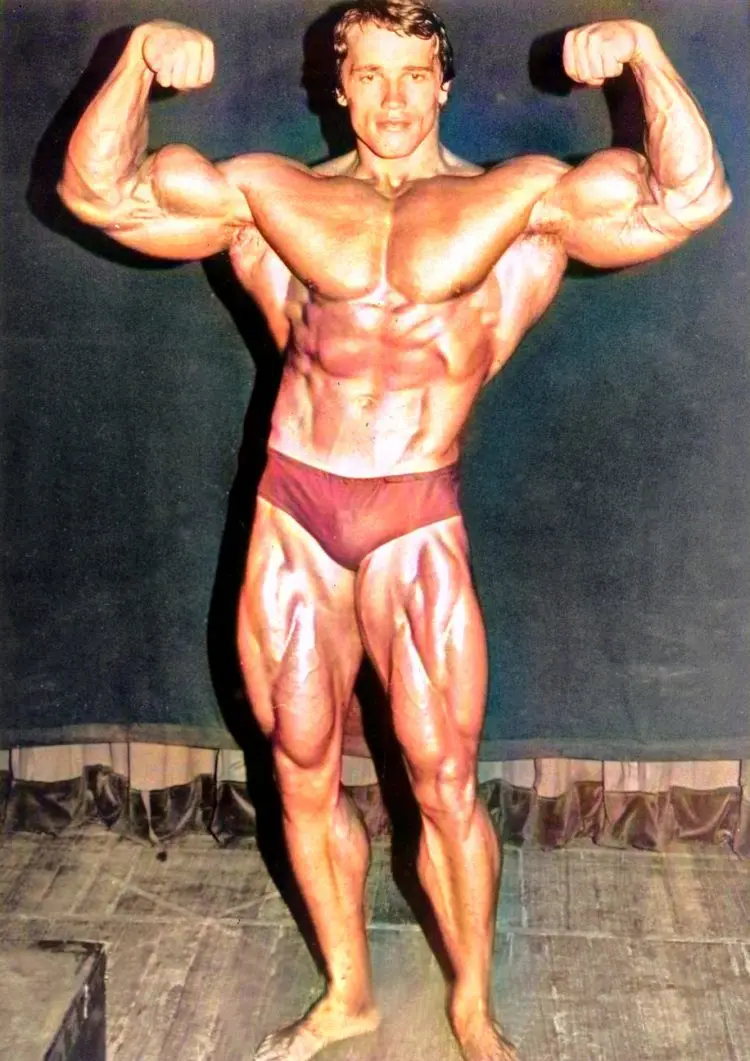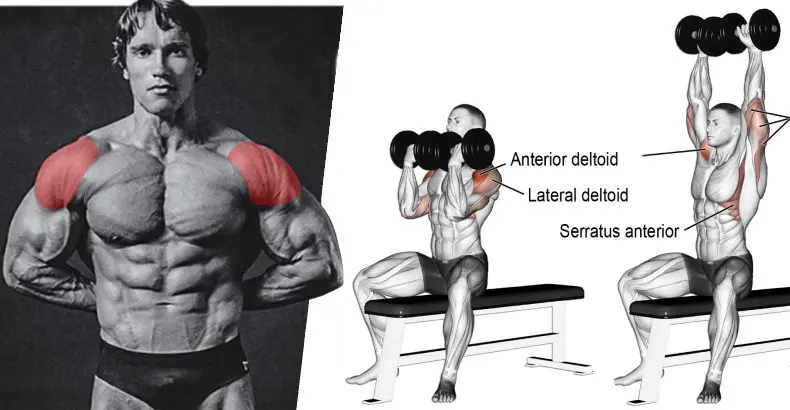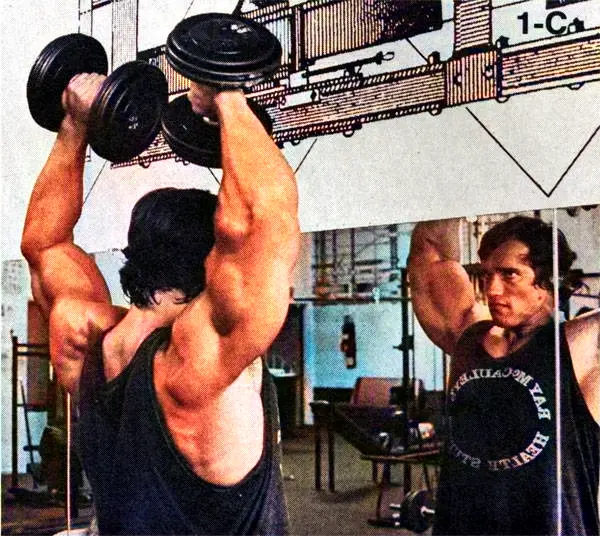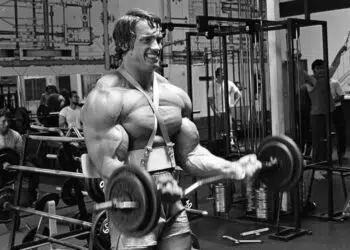The Arnold press is a shoulder exercise that involves rotating the palms outward while lifting dumbbells overhead. It targets the deltoids, triceps, and upper back, helping build upper-body strength and muscle mass.
Arnold Schwarzenegger has contributed immensely to the world of bodybuilding. Whether through the cult-classic documentary Pumping Iron (1977) or his book ‘The New Encyclopedia of Modern Bodybuilding.’
One of his best exercise inventions is the Arnold press, a highly effective variation on the standard Overhead Dumbbell Press.
As a personal trainer, I prescribe the Arnold press to lifers who’ve hit a plateau and need help adding size to their deltoids. Since this exercise involves several moving parts, I have my clients use relatively light weights initially to ensure the target muscles are doing most of the work. Here is everything you need to know about the exercise.
How To Perform The Arnold Press
The Arnold press, like all shoulder exercises, does carry some risks (as you’ll see below). To protect your shoulder joints, it’s important to perform the movement with proper form. The Arnold Press is slightly more complex than the basic shoulder press, but it’s easy enough to master and significantly more effective for building powerful shoulders once you get it right.
You could perform the Arnold press seated or standing. We’ll be sticking with the standing variation for the sake of this article:
Level Up Your Fitness: Join our 💪 strong community in Fitness Volt Newsletter. Get daily inspiration, expert-backed workouts, nutrition tips, the latest in strength sports, and the support you need to reach your goals. Subscribe for free!
Here are step-by-step instructions to perform the Arnold Press:
Step One — Choose an Appropriate Weight
This exercise uses dumbbells. The instability maximizes muscle recruitment, and the one-handed weights allow for greater mobility). So, grab a pair with a neutral grip (palms facing each other) and hold it against your thighs.
Pro Tip: This exercise requires greater stability and balance than the conventional overhead dumbbell shoulder press. Begin with a relatively lighter weight on this exercise to drill the movement mechanics.
Step Two — Take Your Position
Plant your feet hip-width apart and turn your toes out slightly. The stance should feel comfortable and allow you to maintain proper stability in your upper body through your core and legs.
Pro Tip: Keep your knees slightly flexed. Standing with locked-out knees increases the risk of instability mid-set. It also allows you to use a little momentum in the final reps.
Step Three — Bring the Weights To Shoulder Level
From the bottom position, curl the weight to your shoulder level. At the starting position, the dumbbells should be in front of your shoulders, with your palms facing your body and your lower arms at 90 degrees.
The starting position position can vary for each individual depending on their mobility. People who lack shoulder, elbow, and wrist mobility can hold the dumbbells at a slight angle.
Pro Tip: Feel free to use momentum by jerking your lower body to get the weights to shoulder level. This will be especially helpful while lifting heavier weights.
Step Four — Press and Twist
Using only your shoulder and triceps muscles, push the weights upward until your arms are fully extended above your head. During the concentric (upward) phase, turn your wrist outward. Your wrist must face the wall in front of you at the isometric contraction point at the top.
This full rotation helps engage the medial, anterior, and posterior deltoid heads for maximum muscle recruitment.
Pro Tip: Advanced lifters should push their head between their arms during concetrics for maximal shoulder stimulation.
Step Five — Hold at the Top
Pause at the isometric contraction point for a second to increase the time under tension and muscle stimulation to promote hypertrophy. Avoid locking out your elbows at the top, as it can transfer the tension from the shoulders to the elbow and shoulder joints.
Pro Tip: Squeeze the life out of your shoulders at the top of the range of motion. Remember, don’t hold the top for more than a second, as it can hamper your ability to get through the recommended repetitions.
Step Six — Return to the Starting Position
Bring the weights back down to the ready position, controlling their descent. As you lower the weights, twist your wrists in the opposite direction (thumbs turning outward) so you end once more in the ready position with the dumbbells by your head and your palms facing inward.
Again, a slight pause at the bottom of the exercise will increase time under tension and will prevent you from using your momentum to “cheat” and facilitate an easier next rep.
Pro Tip: Breathe in during eccentrics and exhale during concentrics.
It’s absolutely imperative that you control both your ascent (pushing upward) and descent (lowering the weight). Steady, smooth movements will not only increase muscle engagement and time under tension but reduce your risk of wrist, shoulder, and elbow injury.
Arnold Press Tips for Success
For those incorporating the Arnold Press into their training regimens, here are some good tips to maximize muscle engagement, increase safety, and reduce injury risk:
Keep your neck soft and your head steady
You’ll be tempted to tense your neck muscles to help the shoulder muscles push harder, but that’s just going to increase the strain on your already delicate spinal muscles. Make sure your head stays steady and let your neck muscles relax to place all the focus on your shoulders.
Control the range of motion
When pushing, stop your elbows from straightening fully, as that takes the strain off your muscles and places it directly on your bones and joints. When lowering, stop your elbows just before they pass the 90-degree angle (called the “lockout point”) to increase the time under tension for your deltoids.
Stretch your shoulders and back
Increasing your upper back and shoulder mobility will make it easier for you to safely move through the full range of motion on this exercise without experiencing excessive tension or stiffness. It’s always worth spending a few minutes doing targeted upper back and shoulder stretches or foam rolling your muscles and joints before you start your workout.
Use your core muscles to keep your upper body steady
Your abs, obliques, and lower back will support your body to keep you motionless while your arms and shoulders do all the work.
Adjust your weight
If you feel your body moving a lot or you feel the need to “cheat” when you press, lower the weight of your dumbbells and focus on really isolating the motion. This should be smooth, controlled, and cautious.
Avoid leaning back
Many lifters tend to lean back during eccentrics and concentrics. However, this removes tension from the shoulders and transfers it to the chest and upper and lower back muscles. Maintain an upright torso throughout the range of motion to ensure optimal muscle stimulation.
Wear a weightlifting belt
Wearing a weightlifting belt gives you something to brace against, which helps generate thoracic pressure. A weightlifting belt can improve lifting performance and reduce the risk of injury.
Breathe correctly
You should exhale as you push the weights up and inhale as you bring them down. This proper breathing pattern will maximize muscle oxygenation and increase your muscular endurance. Uncontrolled breathing, which includes taking short and fast breaths, can hamper your performance.
Programming (Sets and Reps)
Every exerciser can incorporate the Arnold press into their training regimen irrespective of their training goals. According to a 2021 Sports (Basel) study, here are the loading recommendations for building strength, hypertrophy, and endurance: (1)
Strength
Lifters training with the goal of building strength must use a low repetition scheme with heavy loads. Strength training programs usually involve performing 1-5 repetitions per set with 80-100 percent of one-repetition maximum (1RM).
I don’t really recommend going too heavy on the Arnold press. This is a complex movement that involves movement around the shoulder joint. Losing control during the abduction or internal shoulder rotation can lead to major injuries.
Although powerlifters, weightlifters, and Strongman athletes can incorporate the Arnold press as an accessory lift into their training regimen, I advise using relatively light weights and focusing on form and muscle contraction instead of lifting heavy weights.
Hypertrophy
Arnold primarily developed his namesake exercise to build round, capped shoulders and achieve a 3D look. The Arnold press is a must-have in every bodybuilder’s exercise arsenal.
You must employ a moderate repetition scheme with medium loads to bias hypertrophy. Perform 8 to 12 repetitions per set with 60-80 percent of your 1RM to stimulate the muscle tissue optimally.
This rep range is perfect for all strength sports athletes, including bodybuilders, powerlifters, weightlifters, CrossFitters, Strongmen, and even recreational lifters.
Endurance
A high repetition scheme with light loads, which involves performing 15-plus repetitions per set with loads below 60 percent of your 1RM, optimizes local muscular endurance improvements.
Since this exercise involves complex movement mechanics, I don’t recommend the Arnold press for endurance gains to every athlete. If you decide to perform the Arnold press for such high reps, I suggest stopping the exercise as soon as you notice your form slipping.
Arnold Press Muscles Worked
Primary Muscle Groups
What makes the Arnold press such a great exercise is that it engages all three deltoid muscle heads: anterior (front), lateral (outer), and posterior (rear). The standard shoulder press typically focuses more on the anterior and lateral deltoid heads, but it fails to pay sufficient attention to the less-worked posterior head.
The Arnold press, however, engages all three muscle heads, which not only develops pushing power in the anterior deltoid but also maximizes width and thickness in the lateral deltoid and shoulder joint stability in the posterior deltoid.
Secondary Muscle Groups
Of course, as a bonus, it also recruits the forearms (gripping the weight) and the triceps (needed to push the weight upward). It’s a classic “push” exercise that will make you stronger for push-ups, bench presses, and dips because of the focus on the specific shoulder and arm muscles engaged in whole-body push movements.
Pro Tip: Without a proper focus on the posterior deltoids, your muscles could develop an imbalance. Larger anterior deltoids could actually pull your shoulders forward, giving you a rounded, semi-hunched look. It’s imperative that you train all three parts of the deltoid muscles for a well-balanced look and proper posture maintenance.
Benefits of the Arnold Press
What makes the Arnold Press such a great shoulder exercise? There are a lot of truly excellent benefits to incorporating this movement into your workouts:
Greater time under tension
Because of the added rotation, it actually takes you a second or two longer to complete each Arnold Press repetition than it would to complete a standard
Overhead Press. This means greater time under tension for your deltoid muscles, which may lead to better muscle hypertrophy.
Broad focus
Rather than just training the anterior and lateral heads (like many shoulder-focused exercises do), the Arnold Press engages the posterior head as well, thanks to the rotation of your wrists. This may result in increased strength and hypertrophy.
Improved posture and form
The difficulty of the Arnold Press forces you to focus more on your posture and form as you perform this exercise. You have to keep each movement smooth and controlled in order to protect your joints. By being more conscientious in your training, you’ll notice improvements in your posture even outside the gym.

Enhanced muscle definition
A lot of exercises—including Pull-Ups, Push-Ups, and Bench Presses—focus chiefly on the anterior deltoid, with some lateral deltoid engagement but very little posterior deltoid work. This can lead to strength deficits, but also imbalanced muscle definition. Using the Arnold Press will help to define the posterior deltoid muscles to give you broad, well-rounded shoulders.
Level Up Your Fitness: Join our 💪 strong community in Fitness Volt Newsletter. Get daily inspiration, expert-backed workouts, nutrition tips, the latest in strength sports, and the support you need to reach your goals. Subscribe for free!
It’s definitely an exercise worth adding to your shoulder day!
Common Mistakes While Performing Arnold Press
Performing the Arnold press will not only result in suboptimal gains but also significantly increase injury risk. Remember, quality always trumps quantity in weightlifting.
Here are some of the most common mistakes that you must avoid while doing this shoulder builder:
Incorrect Starting Position
I’ve noticed many novice lifters begin the Arnold press with their palms facing away from them, similar to a traditional shoulder press. Then, they turn their wrists inward on concentrics, reversing the correct form.
The correct starting position is with your palms facing towards you, elbows bent, and weights at shoulder height. This initial posture is crucial for activating the right muscle groups throughout the movement.
Limited Range of Motion
A frequent error I’ve noticed is not fully rotating the arms during concentrics. The arm rotation separates the Arnold press from the other pressing movements. Not doing it correctly beats the entire purpose of this exercise.
Ensure you rotate your arms so your palms face forward at the top of the lift, and then return to the starting position with each rep. This full rotation is essential for maximizing the exercise’s benefits.
That said, people with limited shoulder, elbow, or wrist mobility can restrict arm rotation and range of motion until they can comfortably perform the exercise as intended by Arnie.
Excessive Weight
Most lifters let their egos get the better of them when lifting weights. It’s a common pitfall to prioritize weight over form.
The Arnold Press requires precise muscle coordination and control. Using heavier weights than you can comfortably handle can compromise muscle fiber recruitment.
This reduces the effectiveness of the exercise and increases the risk of injury. Choose a weight that allows you to maintain proper form throughout the set.
Feel free to cut the exercise short if your form starts to slip before completing the recommended rep target.
The Arnold press is one of the few exercises where using a training partner isn’t optimal. Since this exercise involves arm rotation, spotting the Arnold press can lead to instability.
Speed Over Control
Speed is not your ally during the Arnold press. Rushing through the movements can lead to a lack of control, reduced muscle engagement, and significantly increased injury risk.
Focus on a controlled tempo, giving your muscles time to activate and work effectively. Remember, it’s not about how fast you can complete your reps but how well you can perform them.
Pro Tip: Use a two-count on eccentrics to control the rep speed. Conversely, use a 1-2 second concentric rep cadence. Experiment with different rep tempos for optimal muscle stimulation and ignite new growth.
Neglecting Core Stability
The Arnold press involves full upper-body engagement to perform optimally. A stable core is essential for maintaining balance and proper form. Engage your core throughout the exercise to support your spine and prevent unnecessary swinging of the weights.
Using a weightlifting belt can come in handy during the Arnold press. Take in a deep breath and push your abs against the belt for a solid brace. Beginners should perform this exercise seated until they develop the necessary core strength for the standing variation.
Incorrect Elbow Alignment
The elbows are where the magic lies while performing the Arnold press. Your elbows should be below your wrists throughout the exercise.
Flaring your elbows during concentrics can put undue stress on your shoulder joints and diminish the movement’s effectiveness. Keep your elbows in line with your body to ensure proper muscle engagement.
Only after you have mastered this exercise’s line of pull should you attempt to lift heavy.
Overarching the Back
It’s tempting to lean back as you lift, especially when using heavier weights. However, this can strain your lower back and shift the focus away from your shoulders. Keep your back straight and avoid overarching by engaging your core and glutes.
Pro Tip: Perform this exercise standing a few inches in front of a fall to eliminate the risk of overarching your back. This strict version of the Arnold press will lead to maximal shoulder engagement.
Risks of Arnold Press
For all the benefits of this exercise, it does carry a few minor risks. You need to be aware of these potential downsides so you can anticipate them and take steps to prevent them.
The risks of the Arnold press include:
Shoulder impingement
Doing the Arnold press with its added rotation does increase your risk of shoulder impingement. This injury occurs when the rotator cuff (a stabilizer muscle that works with your deltoids) rubs against the humerus (arm bone) and the top outer edge of your shoulder.
The friction can cause swelling, irritation, pain, and reduced mobility. Many trainers and physical therapists will counsel against exercises that cause internal muscle rotation (like the Arnold press) because, over the long term, it raises your risk of shoulder injury and pain.
Using the right form and weight significantly reduces the risk of shoulder impingement.
Related: 10 Best Face Pull Alternatives: Exercises for Better Posture and Shoulder Health.
Wrist pain
For those who lack sufficient grip strength or who have limited mobility in their wrists, the Arnold Press can cause wrist pain because of the added rotation of the weight. The wrists are doing a lot of the twisting work in this exercise, so wrist joints without proper muscle support or strength may be damaged or worn down.
If you experience any pain in your wrists or shoulders while performing the Arnold Press, it may be a good idea to find another exercise to incorporate into your workout routine—rather than risk injury.
See our top wrist wraps picks that can make all the difference for your training.
Arnold Press Variations
The Arnold press is an excellent exercise, and its variations will give you options on how you approach your workout:
1. Seated Arnold Press
The seated variation provides additional support for your lower back without taking the focus off the deltoids. It’s also excellent for beginners trying to improve their form and concentrate on smooth, fluid movement through the ascent and descent.
The training form for this exercise remains the same as the standing Arnold press, with the only difference being you perform this on a utility bench.
Pro Tip: There’s no need to bring the dumbbells together at the top during the Arnold Press. This action can cause instability. Instead, focus on contracting your muscles throughout the range of motion.
2. One-Handed Arnold Press
This variation doubles down on the effectiveness of this exercise, turning it from a shoulder/triceps-focused movement to one that also engages your abs and obliques as well. Unilateral (one-sided) exercises force your core muscles to work to provide stability and maintain your balance.
Pro Tip: Perform one to two reps extra on each set on the lagging side to fix strength and muscle imbalances.
3. Resistance Band Arnold Press
For those with wrist injuries or pain, the weight of a heavy dumbbell may place undue strain on a weakened, stiff, or sore joint. Using resistance bands eliminates the weight directly on your wrist completely.
However, the effectiveness of the shoulder workout is fractionally reduced because there is less instability forcing the shoulder muscles to engage to keep a dumbbell steady throughout the rotation.
Pro Tip: Find a resistance band that suits your biomechanics. Taller individuals should wrap one end of the resistance band around an elevated surface like a flat bench to ensure a full range of motion.
4. Cable Machine Arnold Press
This is another excellent variation to decrease the load directly on your wrists without significantly compromising the effectiveness of the shoulder workout. As long as you have a cable machine, you can perform this exercise easily — seated and standing.
Pro Tip: Perform this exercise on a functional trainer. Avoid using a standard cable machine for this exercise, as the line of pull can put unnecessary strain on your shoulder rotator cuffs.
Arnold Press Alternatives
The Arnold press is one of the few exercises that train all three deltoid heads in a single, fluid movement. Given below are three shoulder exercises that target the anterior, lateral, and posterior heads:
1. Upright Barbell Row
While performing the upright barbell row to target all three delt heads, the key is to use a wider grip and lift the bar to just below chest level.
How To:
- Stand with your feet shoulder-width apart.
- Grab a barbell with your hands using a slightly wider than shoulder-width apart overhand grip.
- I recommend performing this exercise on a squat rack as it eliminates the need to lift the barbell off the floor.
- Keeping the bar close to your body, pull it to your chest level, leading with your elbows.
- Pause at the isometric contraction point.
- Slowly return to the starting position.
Pro Tip: Hold the peak contraction for 2-3 seconds. Then, lean forward slightly during eccentrics to engage the posterior deltoids. This variation trains all three deltoid heads plus the trapezius muscle.
2. Face Pull
While predominantly known for targeting the posterior deltoids, the face pull also works the lateral and anterior deltoids to a degree. How you execute this exercise will determine the level of front and lateral delts.
How To:
- Set the cable pulley at shoulder level.
- Fasten a rope attachment to the pulley and grab it with a neutral grip (palms facing each other).
- Step back and assume a staggered stance to ensure optimal balance.
- Your hands should be together at the starting position.
- Brace your core and pull the rope toward your face, splitting it apart as you do so.
- Focus on retracting and squeezing your shoulder blades together.
- Your hands should be at the sides of your ears at the top of the range of motion.
- Pause and contract your deltoids at the isometric contraction point.
- Ensure that your torso is at 90 degrees throughout the range of motion.
- Slowly return the rope to the starting position.
- Repeat for recommended reps.
Pro Tip: Adjust the angle of the pull, depending on your body mechanics, for maximal anterior and lateral deltoid engagement.
FAQs
How often should I perform the Arnold press?
This depends on your training objectives, experience, and fitness levels. You could perform the Arnold press in every shoulder workout. However, you must give your muscles enough time to rest, recover, and grow bigger and stronger between workouts.
After a high-volume workout, wait for at least 72 hours before training the same muscle group again. Combine your training program with a balanced nutrition and recovery program to speed up your turnaround time.
Can I replace the conventional dumbbell press with the Arnold press?
You could, technically, replace the conventional dumbbell press with the Arnold press. However, you must understand the difference between the two.
The standard dumbbell press biases the anterior delts, whereas the Arnold press works all three shoulder heads. People who want more focused anterior delt exercises should stick with the conventional dumbbell press, whereas people training for overall development can go with the Arnold press.
How heavy should I lift on the Arnold press?
The Arnold press is not an exercise where you should try to set a 1RM world record. This exercise engages multiple muscles and joints, and a minor misstep under heavy weights can easily lead to injury due to the complex movement involved.
Use a weight that allows you to perform 8-10 reps with a picture-perfect form. This is also the best rep and set range to prioritize hypertrophy.
Arnold Press – Wrapping Up
The Arnold press is hands down, one of the best exercises to develop well-rounded, sculpted shoulder muscles. It focuses not just on the commonly targeted anterior deltoid but also increases engagement of the lateral and posterior deltoid. The result: bigger, broader, better-balanced musculature that will look great and give you a serious power boost.
It’s an exercise that will take time and effort to master, but once you’ve learned how to do it safely and smoothly, it will be one of the best in your arsenal of shoulder-shredding workouts.
References
- Schoenfeld, B. J., Grgic, J., Van Every, D. W., & Plotkin, D. L. (2021). Loading Recommendations for Muscle Strength, Hypertrophy, and Local Endurance: A Re-Examination of the Repetition Continuum. Sports, 9(2). https://doi.org/10.3390/sports9020032
Interested in measuring your progress? Check out our strength standards for Bench Press, Push Ups, Face Pull, and more.











